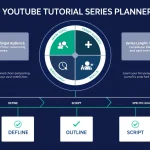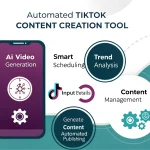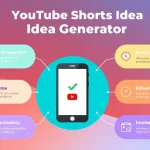Is this tool helpful?
How to Use the Social Media Video Series Brainstorming Tool Effectively
This tool helps you develop creative and focused ideas for your educational social media video series. Follow these steps for the best results:
- Enter your primary teaching topic in the first field. For example, you might use “Remote Team Leadership” or “Healthy Meal Prep”.
- Define your target audience clearly. Consider inputs like “Freelancers and Consultants” or “Busy Parents”.
- Select your preferred video format if you want to specify. Options include “Step-by-Step Tutorials” or “Expert Interviews”.
- Choose the social media platforms where you plan to share your videos, such as “Facebook and YouTube” or “Instagram Stories and LinkedIn”. You can select multiple platforms to tailor your ideas accordingly.
What Is the Social Media Video Series Brainstorming Tool?
This tool is designed to help educators, content creators, and business professionals plan effective and engaging video series for social media. It generates ideas structured around your teaching topic, target audience, content format, and chosen platforms.
By combining these factors, the tool produces a tailored video series outline that matches your educational goals and maximizes audience engagement across different social channels.
Key Features and Benefits
- Topic Breakdown: Divides complex subjects into manageable, teachable segments.
- Audience Alignment: Focuses content on the needs and interests of your viewers.
- Format Suggestion: Recommends presentation styles proven to engage learners.
- Platform Optimization: Adjusts ideas to fit platform-specific video length and style.
How to Apply the Tool to Your Content Planning
Use the brainstorming tool to move from vague ideas to a structured video series plan quickly. Here’s how it supports practical content development:
Series Structure and Flow
- Creates a logical episode sequence based on your topic’s learning objectives.
- Balances information delivery to keep viewers engaged across episodes.
- Integrates calls-to-action and summaries to reinforce key points.
Format and Platform Adaptations
- Suggests formats that match your style and audience preferences, such as tutorials, tips, or interview formats.
- Considers each platform’s unique audience behaviors and video requirements.
- Provides ideas for repurposing content across platforms with tailored adjustments.
Examples of Video Series Ideas Generated by the Tool
Example 1: Leadership Development Series
Inputs:
- Topic: Conflict Resolution Strategies
- Target Audience: Mid-level Managers
- Format: Case Study Discussions
- Platforms: LinkedIn and YouTube
Generated Series Outline:
- Episode 1: Identifying Common Workplace Conflicts
- Episode 2: Communication Techniques to Defuse Tension
- Episode 3: Mediation Best Practices
- Episode 4: Building a Culture of Trust
- Episode 5: Real-life Conflict Resolution Case Studies
Example 2: Wellness and Fitness Education
Inputs:
- Topic: Home Yoga Basics
- Target Audience: Beginners and Senior Adults
- Format: Guided Practice Videos
- Platforms: Instagram Reels and TikTok
Generated Series Outline:
- Episode 1: Breathing and Relaxation Techniques
- Episode 2: Basic Yoga Poses for Flexibility
- Episode 3: Posture and Alignment Tips
- Episode 4: Creating a Daily Routine
- Episode 5: Modifications for Different Ability Levels
Frequently Asked Questions About Planning Educational Video Series
How many episodes should I create for my video series?
Aim for 5 to 10 episodes per series, depending on how complex your topic is and how deeply you want to engage your audience.
What is the ideal video length for different social media platforms?
Video length varies by platform:
- Instagram Reels and TikTok: Up to 60 seconds
- YouTube Shorts: 3 to 5 minutes
- YouTube Standard Tutorials: 7 to 15 minutes
Should I tailor my content differently for each platform?
Yes. Adapt your format, presentation style, and length to match each platform’s audience and algorithm preferences for maximum impact.
How do I keep my educational videos engaging?
Focus on clear objectives, use visual examples, incorporate storytelling, and keep a consistent style. Encourage interaction with questions and call-to-actions.
What structure should each episode follow?
Structure episodes with a brief introduction, key teaching points, a practical demonstration or example, and a summary with next steps or questions.
How often should I release new episodes?
Maintain a regular schedule—weekly or bi-weekly helps build and keep audience interest through consistent engagement.
Can I repurpose the same content for multiple platforms?
Yes, but optimize the style, length, and delivery for each platform to ensure it feels native and resonates with their audiences.
How can I measure the success of my video series?
Track views, watch time, completion rates, comments, shares, and viewer feedback to understand engagement and learning effectiveness.
Important Disclaimer
The calculations, results, and content provided by our tools are not guaranteed to be accurate, complete, or reliable. Users are responsible for verifying and interpreting the results. Our content and tools may contain errors, biases, or inconsistencies. Do not enter personal data, sensitive information, or personally identifiable information in our web forms or tools. Such data entry violates our terms of service and may result in unauthorized disclosure to third parties. We reserve the right to save inputs and outputs from our tools for the purposes of error debugging, bias identification, and performance improvement. External companies providing AI models used in our tools may also save and process data in accordance with their own policies. By using our tools, you consent to this data collection and processing. We reserve the right to limit the usage of our tools based on current usability factors.







